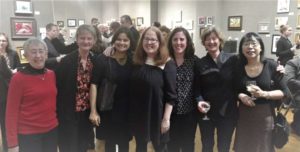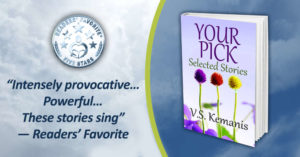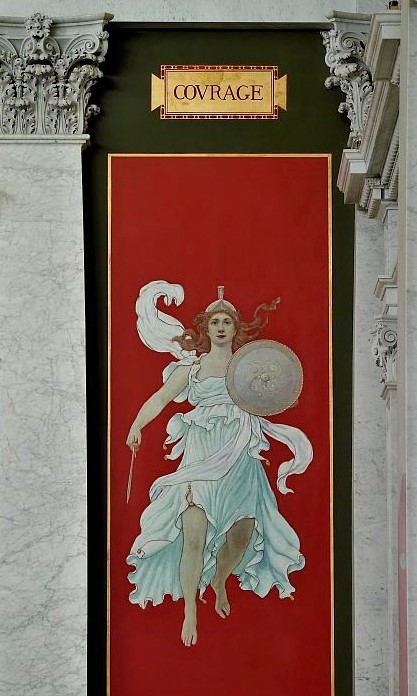
I started writing this travelogue a month ago. Now, as we shelter in to flatten the curve, the crowded restaurants and traffic jams mentioned in this post are from a past world. Let’s hope we’re all on the move again soon.
What do Charlotte, Atlanta, Naples, Savannah, and Washington D.C. have in common? They were all stops on our latest mileage consumption, February 13-25. Twelve days of great discoveries.
First leg, New York to Charlotte, N.C., mostly on I-81. Back roads are nice, but if you must take an interstate, I-81 is quite scenic, especially in the rolling hill country of West Virginia.
Charlotte is a sizable city with a small-town feel. The skyscrapers are beautifully lit at night.

We enjoyed dinner at Duckworth’s (I’ve never seen so many beer pulls and TV screens), where the waiter carded me when I ordered a glass of wine. Yes, you say, that’s because I don’t look a day over 20. (Has nothing to do with Duckworth’s carding policy.)
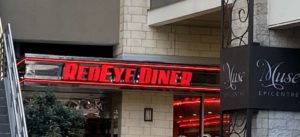 The next morning we had breakfast at the Red Eye Diner, where the motto is: “Life is Short. Eat Great Food and Have Fun.”
The next morning we had breakfast at the Red Eye Diner, where the motto is: “Life is Short. Eat Great Food and Have Fun.”
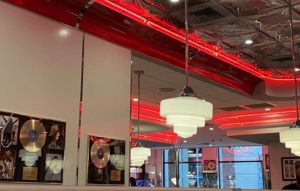
At the Red Eye, you’ll enjoy your comfort food surrounded by iconic photos and souvenirs of rock ’n roll legends.
Then, on to Atlanta, mostly on I-85, where entry into peach country is marked by the tall “Peachoid” water tower in Gaffney, South Carolina.

By late afternoon, we settled into our Airbnb apartment on Peachtree Street NE, then headed to the Cumberland Mall for dinner. It has tons of restaurants and is close to the Cobb Energy Performing Arts Center, where we had tickets for the Atlanta Ballet. Got there, and oops, little did we know that 99% of Atlanta descends on the Mall for Saturday dinner. After circling like raptors, sheer luck got us a spot in the outer reaches of the enormous parking lot. Our trek began. A sea of shimmering cars, inquiries at half a dozen restaurants, all with an hour wait. Time to pull out our tried-and-true strategy. The trick is to spy a couple of empty seats at the bar and waltz past the crush of people at the door. We did this (with the hostess’s blessing) at Ted’s Montana Grill and had a delicious dinner. Seats at the bar can be just as comfortable as a table and far more interesting: You get to watch the bartenders at work.
 The Atlanta Ballet was simply excellent. We saw “Elemental Brubeck” (delightful choreo by Lar Lubovitch, music by Dave Brubeck), “Tuplet” (unique, contemporary, surprising, and funny choreo by Alexander Ekman, music and sound by Mikael Karlsson), and “Sunrise Divine” (contemporary ballet Complexions-style by Dwight Rhoden, arrangement and original music by Dr. Kevin P. Johnson, awesome live gospel performance by the Spelman College Glee Club). And (reality check), at the Cobb Center (unlike Lincoln Center), there are no lines for the ladies’ room at intermission. I commend the architect.
The Atlanta Ballet was simply excellent. We saw “Elemental Brubeck” (delightful choreo by Lar Lubovitch, music by Dave Brubeck), “Tuplet” (unique, contemporary, surprising, and funny choreo by Alexander Ekman, music and sound by Mikael Karlsson), and “Sunrise Divine” (contemporary ballet Complexions-style by Dwight Rhoden, arrangement and original music by Dr. Kevin P. Johnson, awesome live gospel performance by the Spelman College Glee Club). And (reality check), at the Cobb Center (unlike Lincoln Center), there are no lines for the ladies’ room at intermission. I commend the architect.
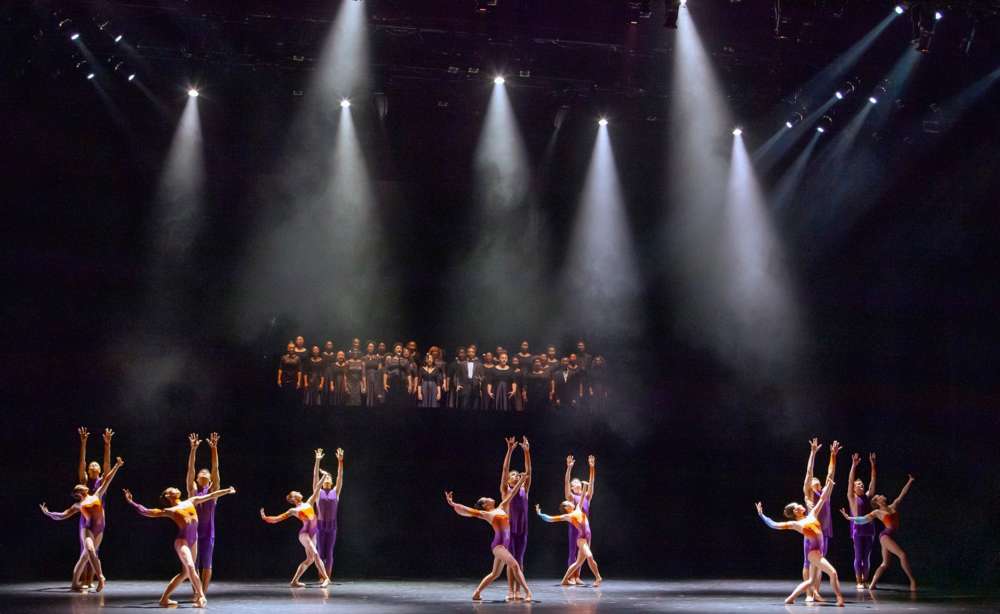
The next day, Sunday, was rainy and cold (45-50˚), not the best for outdoor sightseeing. We started the morning with toasted bagel and coffee at Einstein Bros. Bagels (a favorite of ours when on the road!), and went to the Atlanta History Center. Really interesting. A refresher course on the Civil War, Reconstruction, and the U.S. Supreme Court’s abysmal opinions, 1870s to 1950s, which gutted the early Civil Rights Act and the Equal Protection Clause. Here is a good historical summary of Court decisions on civil rights.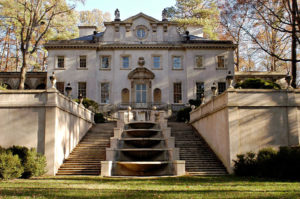
On the museum grounds, we visited the historic Swan House, maintained in the style of a wealthy Atlanta family in the 1930s. My favorite room was the kitchen.
Later that afternoon, my husband gave in to my repeated demands to see the Georgia Aquarium. Once we were there, he had to agree—fish are fine entertainment. They come in an amazing variety of shapes, sizes, and colors, and appear to be just as happy in those large tanks as they would be in their natural habitats, unlike caged and restless zoo animals that stir up your guilt feelings. 
Here is the cool place where they swim on top and all around you.
The Aquarium is in Centennial Olympic Park where the 1996 Summer Olympic Games were held. By the time we finished with the fish it was dinnertime, so we walked across the park to Ruth Chris’s Steakhouse.
A chilly night, but the fog, obscuring parts of the buildings, was very beautiful.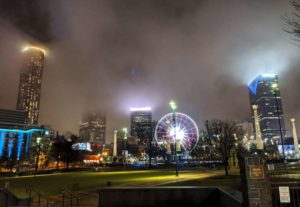
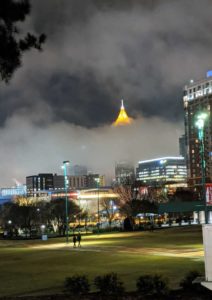
The huge restaurant was half empty, but they still denied us a table. “Reservation only.” (Did we look that bad?) The real reason seemed to be the limited staff for a Sunday. So, again, we grabbed seats at the bar and had a delicious dinner. The best steak I’ve ever eaten. No kidding.
While packing the next morning, I narrowly escaped death from a hidden hazard in our Airbnb: a huge picture came crashing down. Only after the crash did we see that it had not been fastened to the wall but merely propped on a table.
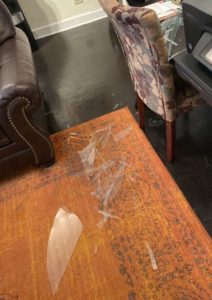
I was so unnerved that I left my travel buddy behind on the bed—not my husband, my favorite memory-foam pillow. A hundred miles down I-75, I noticed the loss. At our next stop, Brooksville FL, I bought another pillow at a Bed Bath and Beyond, and then we had dinner at Carrabba’s Italian Grill. The food was good, but the service somewhat hilarious. The very young, eager-to-please waitperson was so intent on delivering her rehearsed lines that she was deaf to our needs. For example, “Take your time,” was her cheerful directive upon delivering the check as she swept away, with a smile, our coffee and pie, only half-consumed and still desired.
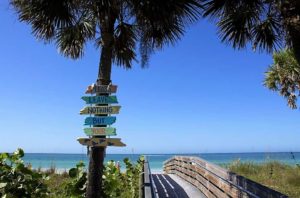 The next morning, we started the last leg to Naples, taking a scenic route. At Tampa, we took I-275 across the bay, picked up to-go lunch at a Publix, and went to Indian Rocks Beach to eat. Finally some warmth after the chilly temperatures in Charlotte and Atlanta!
The next morning, we started the last leg to Naples, taking a scenic route. At Tampa, we took I-275 across the bay, picked up to-go lunch at a Publix, and went to Indian Rocks Beach to eat. Finally some warmth after the chilly temperatures in Charlotte and Atlanta!  After lunch, I couldn’t resist a stop for ice cream at Tropical Ice Cream & Coffee, on Gulf Blvd. Highly recommended!
After lunch, I couldn’t resist a stop for ice cream at Tropical Ice Cream & Coffee, on Gulf Blvd. Highly recommended!
Then, down the peninsula on Routes 699 and 19, through the resort beach towns, to St. Petersburg and onto the amazing Sunshine Skyway Bridge, I-275. Spectacular. Later, I Wikipediaed the Skyway and learned of the disaster in 1980, when a freighter slammed into the southbound span of the old bridge, causing its collapse, killing 35. They used the northbound span until the new bridge opened in 1987, and kept a small section of the old bridge for a fishing pier.

Got to Naples and spent three gorgeous days of sunny weather, 80-85˚, much better than our trip in January 2019, when it was unpleasantly cold and rainy. Naples isn’t new to us, a place to visit family, to have good times, great food and conversation either at home or on the beach or by the pool. A new experience this trip was a pleasant boat ride on the Gordon River at the Conservancy of Southwest Florida. Our boat captain/tour guide, who may have been 101 years old, was very knowledgeable about the mangroves and wildlife. I was only mildly nervous about his navigating abilities.
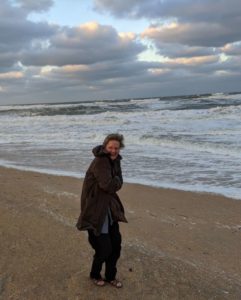 On Friday, Feb 21, we left Naples and drove to St. Augustine, arriving about 6 p.m., after construction and traffic jams around Orlando. Goodbye warm weather. Freezing and windy! We crossed the Tolomato River on the Francis and Mary Usina Bridge from St. Augustine to Vilano Beach. Do I look like I’m having fun?
On Friday, Feb 21, we left Naples and drove to St. Augustine, arriving about 6 p.m., after construction and traffic jams around Orlando. Goodbye warm weather. Freezing and windy! We crossed the Tolomato River on the Francis and Mary Usina Bridge from St. Augustine to Vilano Beach. Do I look like I’m having fun?
As you might guess, our “walk” on the beach lasted two minutes. I’d like to visit the beautiful Vilano Beach again someday—when it’s warm.
We had a nice dinner at 180 Vilano Grill (seafood for me, pizza for Kevin). The food was delish, but we were seated in the last available booth, directly across from the bathroom door, which I kept closing when people left it open. Our tendency to choose crowded restaurants must be a sign of our instinct for finding the best ones!
That night, we stayed at the Hampton Inn & Suites in Vilano Beach, where dozens of ladies wearing pirate hats were having a convention, eating pizza and salad in the lobby and ballroom. Our room was very nice, but gave us an unpleasant surprise. As usual, I got out of bed in the middle of the night, not bothering to turn on the lights. Too blinding. Then, very strange. Was I dreaming? In the dark bathroom, I padded through a thin layer of water. There’d been a slow leak in a pipe under the sink. The bottom of my PJs got wet. Luckily, I had another pair.
The next day, Saturday Feb 22, we left St. Augustine and drove north on Route 1, a nice wide parkway (part of the “Dixie Highway”) Near Jacksonville, we took I-295 over the St. Johns River on another impressive cable bridge, the Dames Point Bridge (officially the Napoleon Bonaparte Broward Bridge).
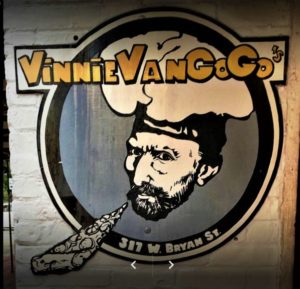 About 2 o’clock we stopped in Savannah GA for lunch. The historic district was hopping with live music and people shamelessly imbibing on the streets, already half drunk. Then it dawned on us, oh, yeah, this is the weekend before Mardi Gras (either that, or Savannah is a 24/7 party town). Drinking and carousing didn’t appeal to us, so we got in line for a table at Vinny Van Go-Go’s Pizza. Yes, another crowded restaurant. The pizza was pretty good. Cash only! Not many places like that are still around. Luckily, we had the cash, and not much was needed. Conveniently next door was a fabulous ice cream place, Savannah’s Candy Kitchen. As you might guess, I was not about to resist.
About 2 o’clock we stopped in Savannah GA for lunch. The historic district was hopping with live music and people shamelessly imbibing on the streets, already half drunk. Then it dawned on us, oh, yeah, this is the weekend before Mardi Gras (either that, or Savannah is a 24/7 party town). Drinking and carousing didn’t appeal to us, so we got in line for a table at Vinny Van Go-Go’s Pizza. Yes, another crowded restaurant. The pizza was pretty good. Cash only! Not many places like that are still around. Luckily, we had the cash, and not much was needed. Conveniently next door was a fabulous ice cream place, Savannah’s Candy Kitchen. As you might guess, I was not about to resist.
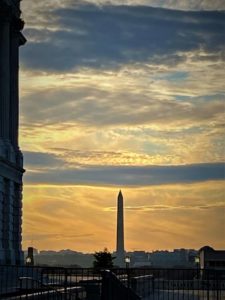 Thus refreshed, we drove to our next stop, Fayetteville NC, for an overnight rest before completing the drive to Washington D.C. The next day on I-95, there was an accident near Richmond VA, and the Google lady told us to take exit 104 to US 301. A lovely detour. We enjoyed this nice little highway with cows and farms and hills before getting into D.C., late afternoon. Checked into the Washington Court Hotel on New Jersey Avenue. Comfortable and very convenient to the Mall. After a stroll at sunset, we had a lovely dinner at the bistro in the hotel.
Thus refreshed, we drove to our next stop, Fayetteville NC, for an overnight rest before completing the drive to Washington D.C. The next day on I-95, there was an accident near Richmond VA, and the Google lady told us to take exit 104 to US 301. A lovely detour. We enjoyed this nice little highway with cows and farms and hills before getting into D.C., late afternoon. Checked into the Washington Court Hotel on New Jersey Avenue. Comfortable and very convenient to the Mall. After a stroll at sunset, we had a lovely dinner at the bistro in the hotel.
Monday February 24, legislators were back at work after their Presidents’ Week break. We went to Kirstin Gillibrand’s office in the Russell Senate Office building, and an intern gave us passes to the House and Senate Galleries. The Russell building, like all the government buildings we visited, is fitted with opulent amounts of marble, hallways as wide as two-lane highways, and ceilings 20 feet above our heads. Grand and beautiful, with its implicit statement of lofty purpose, but undoubtedly a fortune in tax dollars to heat, cool, and maintain.
Our next stop was Congress, where nothing was happening. We saw the empty House chamber and decided to return at 3 p.m., when the Senate would be in session. We walked past the U.S. Supreme Court, where oral argument was underway in the case of U.S. Forest Service and Atlantic Coast Pipeline LLC v Cowpasture River Preservation Assn. At stake in this case (read here) is a permit for a right-of-way for a natural gas pipeline to tunnel 600 feet beneath the Appalachian Trail. Outside the Court were a few news reporters, demonstrators opposed to the pipeline, and a blocks-long line to get inside for a three-minute look at oral argument.

 We declined the opportunity to spend hours in that line, instead going next door to the Library of Congress, resplendent with beautiful art and inspirational quotes on the walls, ceilings, lunettes. Here is one of the paintings of the ideals (all female, of course) Wisdom, Understanding, Knowledge, and Philosophy.
We declined the opportunity to spend hours in that line, instead going next door to the Library of Congress, resplendent with beautiful art and inspirational quotes on the walls, ceilings, lunettes. Here is one of the paintings of the ideals (all female, of course) Wisdom, Understanding, Knowledge, and Philosophy.
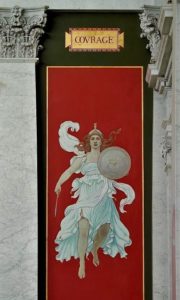 Another favorite of mine is the mural panel “Courage” by artist George Willoughby Maynard, not to be mistaken as COVERAGE, spelled with a typo. I suppose our desire to look erudite is the driving motivation behind adherence to the ancient Roman convention of using V’s instead of U’s.
Another favorite of mine is the mural panel “Courage” by artist George Willoughby Maynard, not to be mistaken as COVERAGE, spelled with a typo. I suppose our desire to look erudite is the driving motivation behind adherence to the ancient Roman convention of using V’s instead of U’s.
The Library houses several interesting exhibits. We spent the most time in Exploring the Early Americas (read: Invading the Early Americas), with its interactive maps of indigenous peoples dealing with and defending against self-entitled Europeans.
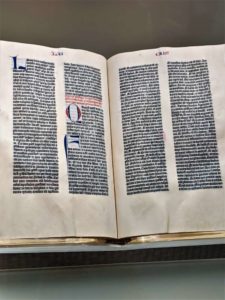 Here is the Gutenberg Bible, the first book printed from movable metal type in 1455.
Here is the Gutenberg Bible, the first book printed from movable metal type in 1455.
We had lunch in the spacious 6th floor cafeteria in the James Madison Memorial Building. Tons of food choices, a wall of windows on the city, and swarms of government employees (giving me flashbacks of my lunch breaks in years gone by). We returned to the Supreme Court (oral argument now over), and sat in the courtroom, listening to an energetic former federal law clerk, who finished her lecture about the Court with a punchline: The highest court in the land is not the one we were sitting in but the one directly above us on a higher floor—a basketball court for the Justices and their staffs. Yours Truly, Esq., did not learn much of anything new from the lecture, but my curiosity was satisfied, seeing the space where important cases are heard. The magnificence of the courtroom does not outclass the beautiful New York appellate courts where I have argued and worked, the First and Second Department Appellate Divisions, respectively.
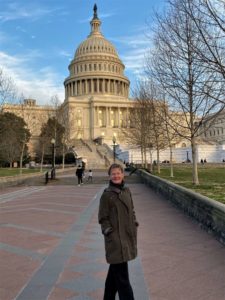 We were back on Capitol Hill at 2:30, hopefully in time for the pledge of allegiance and opening prayer at 3:00, but security took too long. When we tiptoed into the Senate gallery (balcony) at about 3:20, Senator Tammy Baldwin (D-Wisconsin) was standing at the podium, facing the empty chamber, reading a speech. We were mystified. Was this a rehearsal of some kind? All 100 seats were empty, each desk with a little white booklet in the middle. Behind Senator Baldwin sat the presiding officer (not VP Pence or President Pro Tempore Grassley but a designee). At the long desk in front of her sat a few officials (e.g. legislative clerk and secretary), and on the carpeted steps on the sides sat a dozen or more 16-year-old pages, eager for something to do. Occasionally, one would jump up and deliver a glass of water to the presiding officer, who seemed to need four or five cupsful during the speech. It was quite long.
We were back on Capitol Hill at 2:30, hopefully in time for the pledge of allegiance and opening prayer at 3:00, but security took too long. When we tiptoed into the Senate gallery (balcony) at about 3:20, Senator Tammy Baldwin (D-Wisconsin) was standing at the podium, facing the empty chamber, reading a speech. We were mystified. Was this a rehearsal of some kind? All 100 seats were empty, each desk with a little white booklet in the middle. Behind Senator Baldwin sat the presiding officer (not VP Pence or President Pro Tempore Grassley but a designee). At the long desk in front of her sat a few officials (e.g. legislative clerk and secretary), and on the carpeted steps on the sides sat a dozen or more 16-year-old pages, eager for something to do. Occasionally, one would jump up and deliver a glass of water to the presiding officer, who seemed to need four or five cupsful during the speech. It was quite long.
Soon enough, it became clear that the speech was a relic of the past. I peeked over the shoulder of the woman sitting next to me, who was following along in one of those little white booklets. (How did we miss getting one of those?) It was President Washington’s Farewell Address from 1796. Later, I learned of the yearly Senate tradition, dating back to 1888, for a different Senator to deliver the Address during the week of Washington’s birthday. Perhaps it’s time to reconsider this tradition? We could save on printing costs for all those wasted little booklets. The Senators aren’t interested.
To give you a flavor, here is the opening paragraph-long sentence of Washington’s speech:
“The period for a new election of a citizen to administer the executive government of the United States being not far distant, and the time actually arrived when your thoughts must be employed in designating the person who is to be clothed with that important trust, it appears to me proper, especially as it may conduce to a more distinct expression of the public voice, that I should now apprise you of the resolution I have formed, to decline being considered among the number of those out of whom a choice is to be made.”
Translation: “I’m not running for a third term.”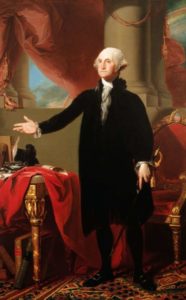
Washington’s advice, designed to inspire and guide future generations (i.e. us), is to beware the forces of geographical sectionalism, political factionalism, and foreign influence as potentially undermining our national interest, our independence, and republican form of government. Here is Washington’s Farewell Address, just in case you are dying to read it.
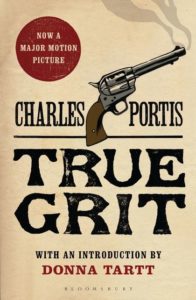 Still awake when the speech ended, we stuck around for another hour and saw several senators speak for about 10 minutes each. One by one, they addressed an empty chamber, as a stenographer stood nearby, typing on a steno machine hanging from her neck. Sen. McConnell recognized the career of retired Navy Adm. Joseph Maguire whose service as acting Director of National Intelligence “concluded last week” (read: he was replaced); Sen. Casey honored three people from Pennsylvania for Black History Month; Sen. Cornyn spoke in support of bills to prohibit abortions after 20 weeks and to protect babies born alive during late-term abortions; and Sen. Boozman spoke in support of a bill to improve delivery of veterans’ health care, then paid tribute to the author of True Grit, Charles Portis, who had just died in his home state of Arkansas. At the outset of each speech, the presiding officer granted, “without objection,” the senator’s request, stated differently by each, that “the quorum call be rescinded” or “be dispensed with” or “be vitiated.”
Still awake when the speech ended, we stuck around for another hour and saw several senators speak for about 10 minutes each. One by one, they addressed an empty chamber, as a stenographer stood nearby, typing on a steno machine hanging from her neck. Sen. McConnell recognized the career of retired Navy Adm. Joseph Maguire whose service as acting Director of National Intelligence “concluded last week” (read: he was replaced); Sen. Casey honored three people from Pennsylvania for Black History Month; Sen. Cornyn spoke in support of bills to prohibit abortions after 20 weeks and to protect babies born alive during late-term abortions; and Sen. Boozman spoke in support of a bill to improve delivery of veterans’ health care, then paid tribute to the author of True Grit, Charles Portis, who had just died in his home state of Arkansas. At the outset of each speech, the presiding officer granted, “without objection,” the senator’s request, stated differently by each, that “the quorum call be rescinded” or “be dispensed with” or “be vitiated.”
This experience disabused me of my impression that a quorum of senators is present in the chamber during speeches like this. If you watch Senate proceedings on TV, it’s not so obvious that no one is in the room. At about quarter after five we had to leave, not knowing that (found out later) the session went on until almost 8 p.m. You can watch the entire five hours here on CSpan.
We met our nephew at Reren Lamen & Bar for delicious Asian fusion cuisine and good conversation. The wall with the big green dragon is great background for selfies. The next morning was rainy and cold and we were all vacationed out. We abandoned our tentative plans for more touring and hit the road home.
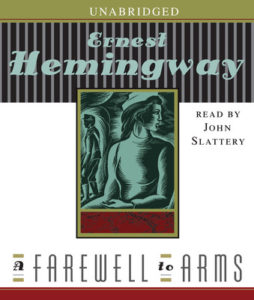 A final, very important note: With all those hours in the car, audiobooks are essential. We listened to two. On the way to Florida, it was The Accident by Chris Pavone, about an anonymous manuscript that contains a dark secret about a powerful mogul and the various people who get murdered for trying to publish or profit from it. Entertaining for a car trip, but I found Pavone’s first novel, The Expats, a better thriller. On the way home we listened to the classic, A Farewell to Arms by Ernest Hemingway. I highly recommend this audiobook, read by John Slattery, who brings the characters alive with his excellent narration.
A final, very important note: With all those hours in the car, audiobooks are essential. We listened to two. On the way to Florida, it was The Accident by Chris Pavone, about an anonymous manuscript that contains a dark secret about a powerful mogul and the various people who get murdered for trying to publish or profit from it. Entertaining for a car trip, but I found Pavone’s first novel, The Expats, a better thriller. On the way home we listened to the classic, A Farewell to Arms by Ernest Hemingway. I highly recommend this audiobook, read by John Slattery, who brings the characters alive with his excellent narration.
Yes, this has been a long blog post, something to fill up the stay-at-home-itis. Congratulations are due anyone reading this to the end. Email me for your free prize, an e-book of your choice!
Let’s hope we’ll all be traveling and dining out again soon. Stay safe and healthy.
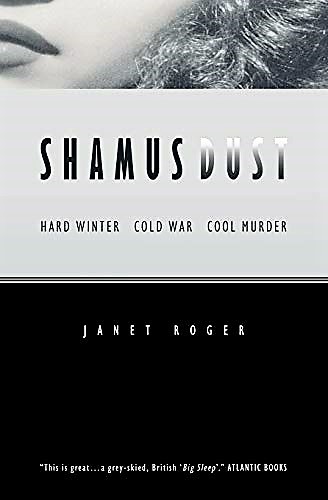
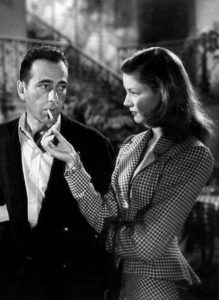 Give me another sec. Almost here, still a bit there. Let me knock back the last tumbler of gin and crush out my red lipstick-stained cigarette. Unfiltered.
Give me another sec. Almost here, still a bit there. Let me knock back the last tumbler of gin and crush out my red lipstick-stained cigarette. Unfiltered.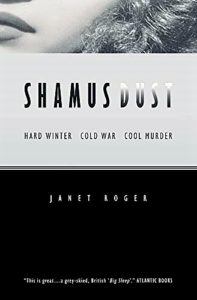 Shamus Dust is not a beach read or superficial entertainment to pick up when you’re mildly distracted. You’ll need to take this one slowly to savor the language, its sophistication, wit, irony, unique metaphors, and turns of phrase. You’ll need time to ponder the complexity of the plot. The author honors the reader’s intelligence, never overstates, poses one intriguing puzzle after another. She follows Newman through London without revealing what he’s up to in a scene until, several pages on, the reader is allowed to discover the meaning of the interaction. There are many of these “ah-ha” moments, opportunities to marvel at the cleverly interlacing intricacies.
Shamus Dust is not a beach read or superficial entertainment to pick up when you’re mildly distracted. You’ll need to take this one slowly to savor the language, its sophistication, wit, irony, unique metaphors, and turns of phrase. You’ll need time to ponder the complexity of the plot. The author honors the reader’s intelligence, never overstates, poses one intriguing puzzle after another. She follows Newman through London without revealing what he’s up to in a scene until, several pages on, the reader is allowed to discover the meaning of the interaction. There are many of these “ah-ha” moments, opportunities to marvel at the cleverly interlacing intricacies.


 The next morning we had breakfast at the
The next morning we had breakfast at the 








 The next morning, we started the last leg to Naples, taking a scenic route. At Tampa, we took I-275 across the bay, picked up to-go lunch at a Publix, and went to Indian Rocks Beach to eat. Finally some warmth after the chilly temperatures in Charlotte and Atlanta!
The next morning, we started the last leg to Naples, taking a scenic route. At Tampa, we took I-275 across the bay, picked up to-go lunch at a Publix, and went to Indian Rocks Beach to eat. Finally some warmth after the chilly temperatures in Charlotte and Atlanta!  After lunch, I couldn’t resist a stop for ice cream at Tropical Ice Cream & Coffee, on Gulf Blvd. Highly recommended!
After lunch, I couldn’t resist a stop for ice cream at Tropical Ice Cream & Coffee, on Gulf Blvd. Highly recommended!
 On Friday, Feb 21, we left Naples and drove to St. Augustine, arriving about 6 p.m., after construction and traffic jams around Orlando. Goodbye warm weather. Freezing and windy! We crossed the Tolomato River on the Francis and Mary Usina Bridge from
On Friday, Feb 21, we left Naples and drove to St. Augustine, arriving about 6 p.m., after construction and traffic jams around Orlando. Goodbye warm weather. Freezing and windy! We crossed the Tolomato River on the Francis and Mary Usina Bridge from  About 2 o’clock we stopped in Savannah GA for lunch. The historic district was hopping with live music and people shamelessly imbibing on the streets, already half drunk. Then it dawned on us, oh, yeah, this is the weekend before Mardi Gras (either that, or Savannah is a 24/7 party town). Drinking and carousing didn’t appeal to us, so we got in line for a table at
About 2 o’clock we stopped in Savannah GA for lunch. The historic district was hopping with live music and people shamelessly imbibing on the streets, already half drunk. Then it dawned on us, oh, yeah, this is the weekend before Mardi Gras (either that, or Savannah is a 24/7 party town). Drinking and carousing didn’t appeal to us, so we got in line for a table at  Thus refreshed, we drove to our next stop, Fayetteville NC, for an overnight rest before completing the drive to Washington D.C. The next day on I-95, there was an accident near Richmond VA, and the Google lady told us to take exit 104 to US 301. A lovely detour. We enjoyed this nice little highway with cows and farms and hills before getting into D.C., late afternoon. Checked into the
Thus refreshed, we drove to our next stop, Fayetteville NC, for an overnight rest before completing the drive to Washington D.C. The next day on I-95, there was an accident near Richmond VA, and the Google lady told us to take exit 104 to US 301. A lovely detour. We enjoyed this nice little highway with cows and farms and hills before getting into D.C., late afternoon. Checked into the 
 We declined the opportunity to spend hours in that line, instead going next door to the
We declined the opportunity to spend hours in that line, instead going next door to the  Another favorite of mine is the mural panel “Courage” by artist
Another favorite of mine is the mural panel “Courage” by artist  Here is the
Here is the  We were back on Capitol Hill at 2:30, hopefully in time for the pledge of allegiance and opening prayer at 3:00, but security took too long. When we tiptoed into the Senate gallery (balcony) at about 3:20, Senator Tammy Baldwin (D-Wisconsin) was standing at the podium, facing the empty chamber, reading a speech. We were mystified. Was this a rehearsal of some kind? All 100 seats were empty, each desk with a little white booklet in the middle. Behind Senator Baldwin sat the presiding officer (not VP Pence or President Pro Tempore Grassley but a designee). At the long desk in front of her sat a few officials (e.g. legislative clerk and secretary), and on the carpeted steps on the sides sat a dozen or more 16-year-old pages, eager for something to do. Occasionally, one would jump up and deliver a glass of water to the presiding officer, who seemed to need four or five cupsful during the speech. It was quite long.
We were back on Capitol Hill at 2:30, hopefully in time for the pledge of allegiance and opening prayer at 3:00, but security took too long. When we tiptoed into the Senate gallery (balcony) at about 3:20, Senator Tammy Baldwin (D-Wisconsin) was standing at the podium, facing the empty chamber, reading a speech. We were mystified. Was this a rehearsal of some kind? All 100 seats were empty, each desk with a little white booklet in the middle. Behind Senator Baldwin sat the presiding officer (not VP Pence or President Pro Tempore Grassley but a designee). At the long desk in front of her sat a few officials (e.g. legislative clerk and secretary), and on the carpeted steps on the sides sat a dozen or more 16-year-old pages, eager for something to do. Occasionally, one would jump up and deliver a glass of water to the presiding officer, who seemed to need four or five cupsful during the speech. It was quite long.
 Still awake when the speech ended, we stuck around for another hour and saw several senators speak for about 10 minutes each. One by one, they addressed an empty chamber, as a stenographer stood nearby, typing on a steno machine hanging from her neck. Sen. McConnell recognized the career of retired Navy Adm. Joseph Maguire whose service as acting Director of National Intelligence “concluded last week” (read: he was replaced); Sen. Casey honored three people from Pennsylvania for Black History Month; Sen. Cornyn spoke in support of bills to prohibit abortions after 20 weeks and to protect babies born alive during late-term abortions; and Sen. Boozman spoke in support of a bill to improve delivery of veterans’ health care, then paid tribute to the author of True Grit,
Still awake when the speech ended, we stuck around for another hour and saw several senators speak for about 10 minutes each. One by one, they addressed an empty chamber, as a stenographer stood nearby, typing on a steno machine hanging from her neck. Sen. McConnell recognized the career of retired Navy Adm. Joseph Maguire whose service as acting Director of National Intelligence “concluded last week” (read: he was replaced); Sen. Casey honored three people from Pennsylvania for Black History Month; Sen. Cornyn spoke in support of bills to prohibit abortions after 20 weeks and to protect babies born alive during late-term abortions; and Sen. Boozman spoke in support of a bill to improve delivery of veterans’ health care, then paid tribute to the author of True Grit,  A final, very important note: With all those hours in the car, audiobooks are essential. We listened to two. On the way to Florida, it was
A final, very important note: With all those hours in the car, audiobooks are essential. We listened to two. On the way to Florida, it was 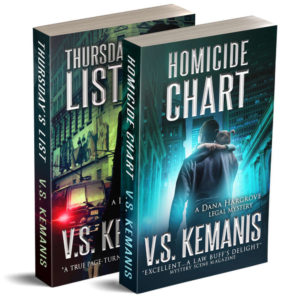
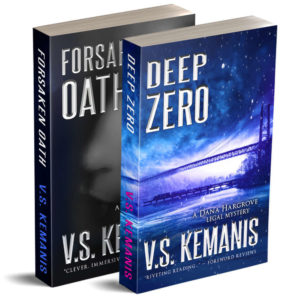
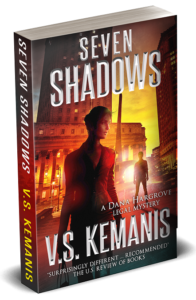
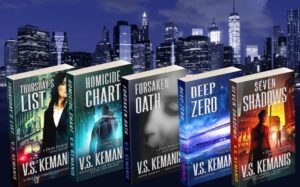
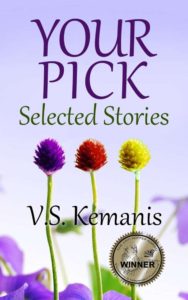

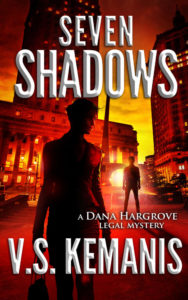
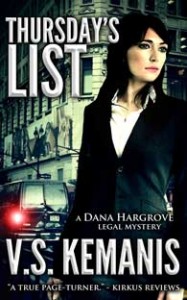
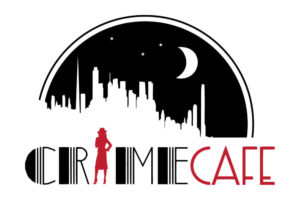


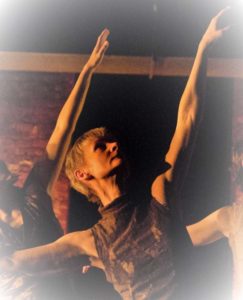
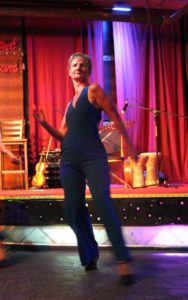 A day for reflection, to be grateful for a loving family, close friends, sound health, and the good fortune to be living in a time and place that affords women the freedom to work in artistic and intellectually stimulating fields. For me, that means law, fiction writing, and dance. Not necessary in that order and sometimes simultaneously!
A day for reflection, to be grateful for a loving family, close friends, sound health, and the good fortune to be living in a time and place that affords women the freedom to work in artistic and intellectually stimulating fields. For me, that means law, fiction writing, and dance. Not necessary in that order and sometimes simultaneously!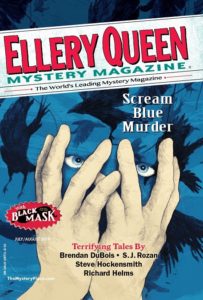 “
“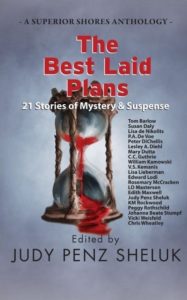 Released in June, the anthology
Released in June, the anthology 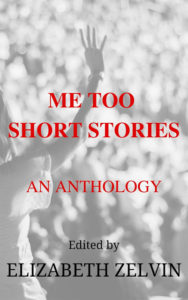 Coming in September from
Coming in September from 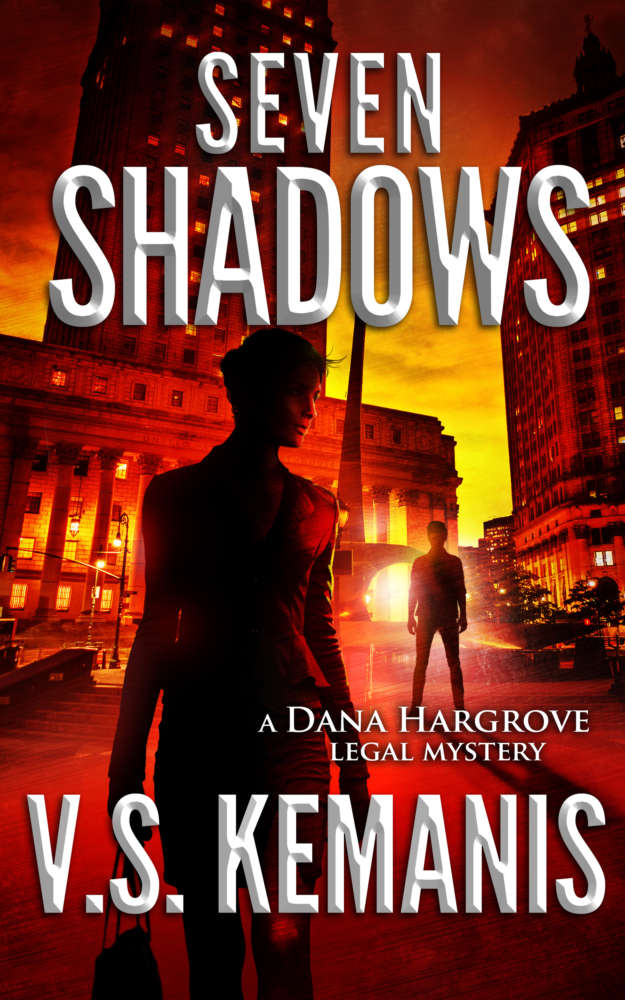



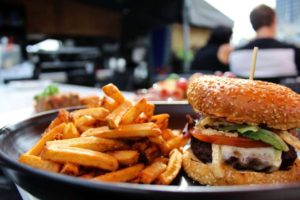
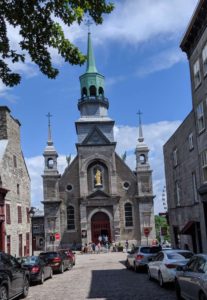
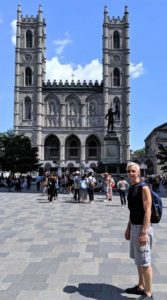

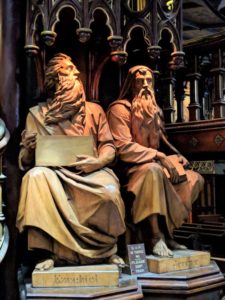



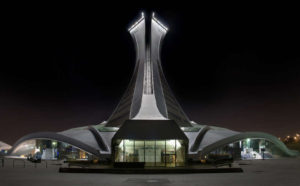
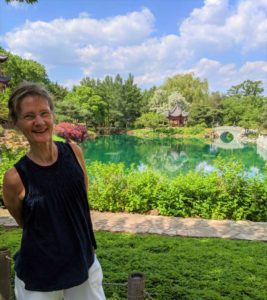
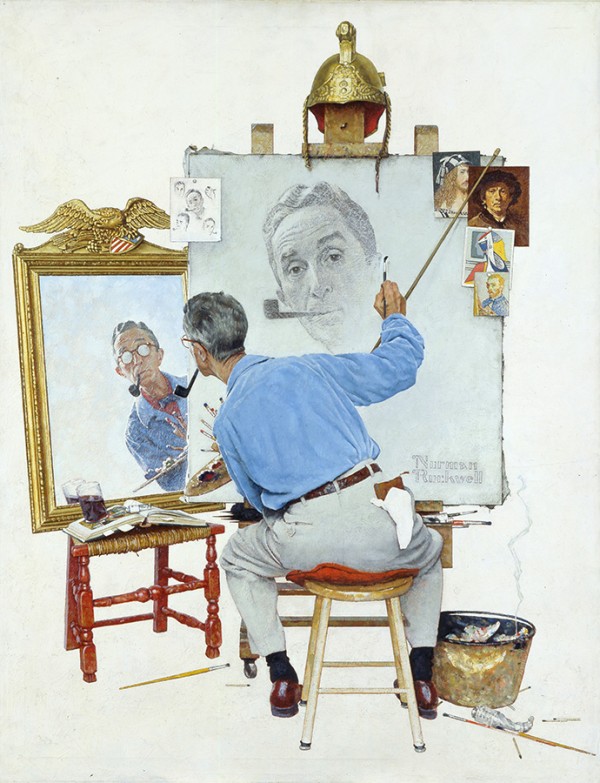
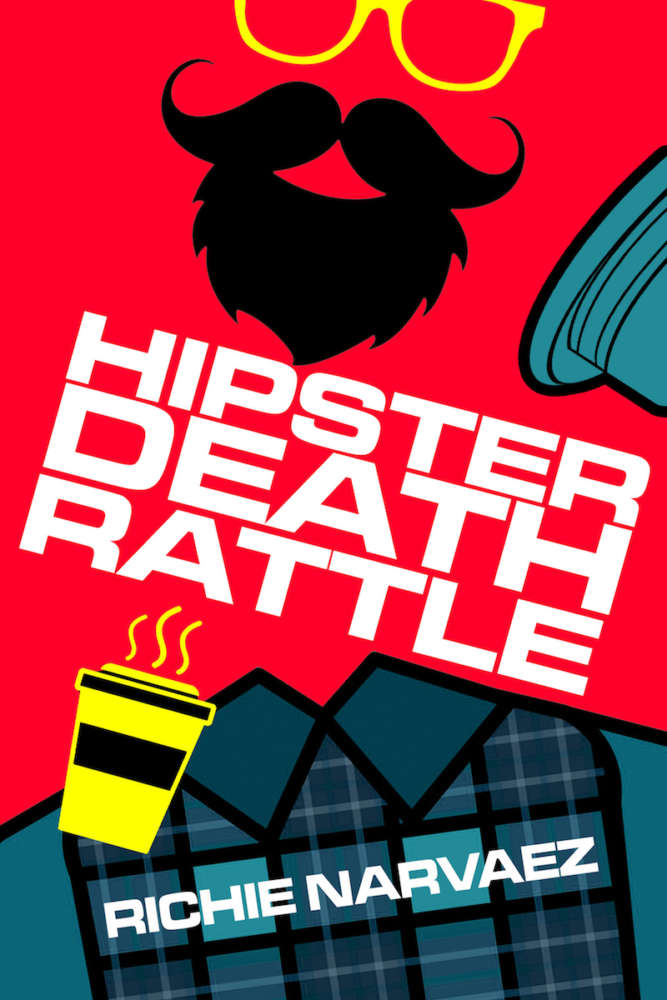
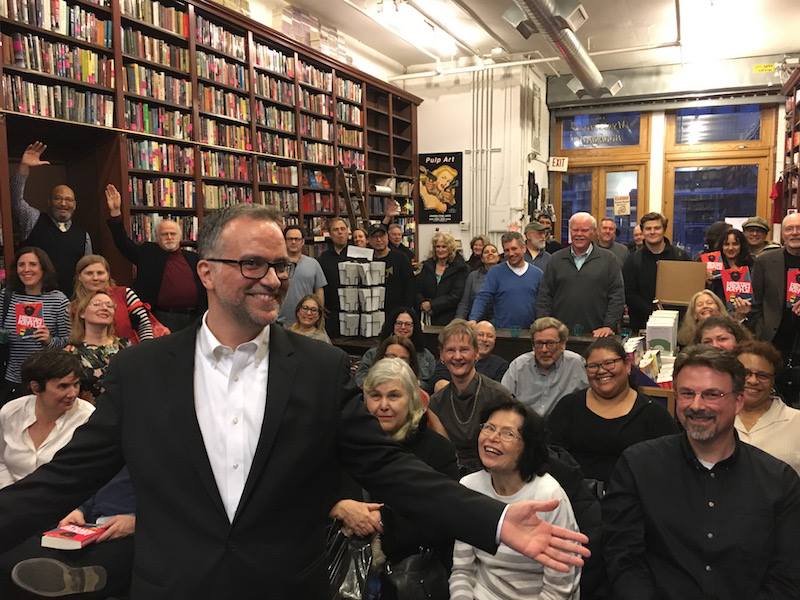

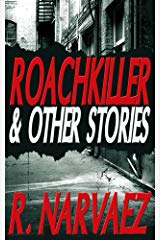
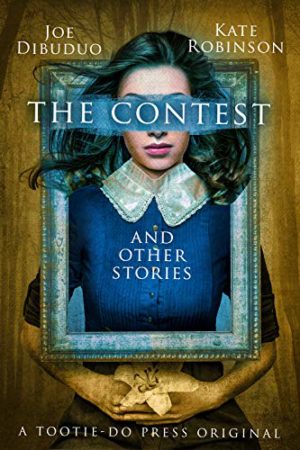
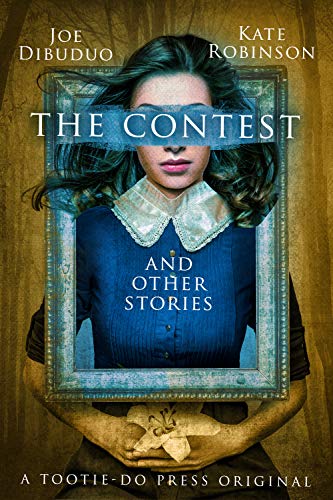

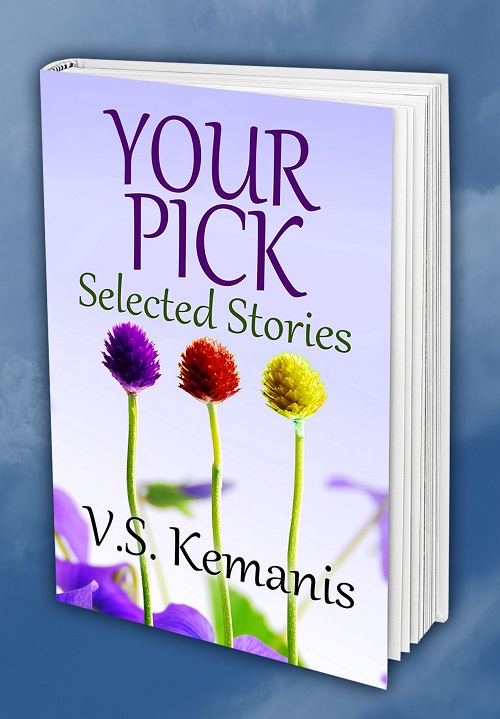
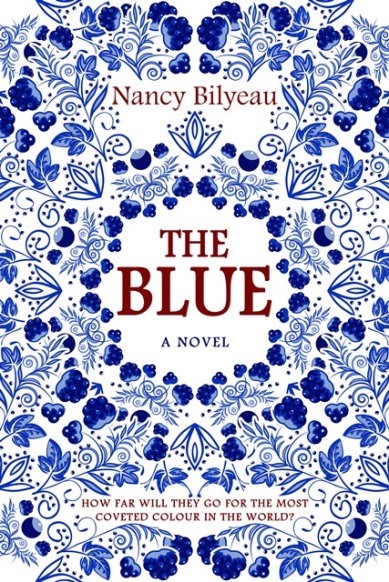
 I named a character, Pierre Billiou, after my own ancestor, though it is not his life I am describing. I wanted to pay homage to my Huguenot background by using his name. The Pierre in my novel fled France for England as a young child after Louis XIV took action against the Protestants in his kingdom in 1685—it’s called the Revocation of the Edict of Nantes. Basically, the King was canceling the measures of tolerance for Protestants. He wanted France to be One King, One Faith. Pierre and his family settled in Spitalfields, in London. My book takes place in England and France, so I needed to make these changes.
I named a character, Pierre Billiou, after my own ancestor, though it is not his life I am describing. I wanted to pay homage to my Huguenot background by using his name. The Pierre in my novel fled France for England as a young child after Louis XIV took action against the Protestants in his kingdom in 1685—it’s called the Revocation of the Edict of Nantes. Basically, the King was canceling the measures of tolerance for Protestants. He wanted France to be One King, One Faith. Pierre and his family settled in Spitalfields, in London. My book takes place in England and France, so I needed to make these changes.